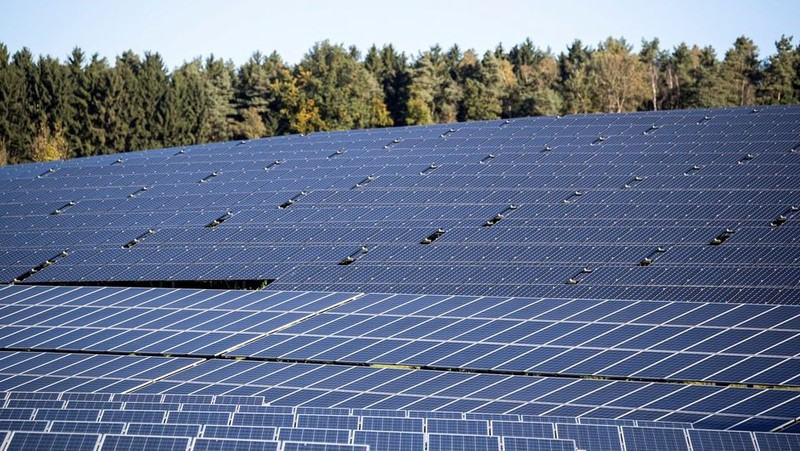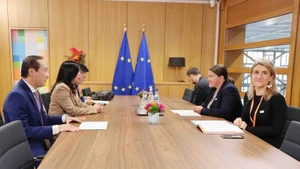Recently published data showed that green electricity has reached a high rate in some European countries and many countries in the region are aiming to become a green energy centre.
The strong development of wind and solar energy has brought benefits, reducing the thirst for energy supplies in many European countries.
According to experts, renewable energy has reduced the impact of drought, electricity prices and emissions on the environment across the EU. This trend is expected to continue to increase as EU countries have been stepping up efforts in energy transition.
According to figures from the European Solar Photovoltaic Industry Alliance, the new solar photovoltaic capacity of the 27 EU member states reached 41.4 gigawatts (GW) in 2022, a year-on-year increase of 47%.
One of the pioneering countries using renewable energy sources is Austria. The country’s Ministry of Climate Action, Environment, Energy, Mobility, Innovation and Technology said, with 78% of its electricity generation coming from green energy, Austria is moving towards its ambition to phase out fossil fuels and reach carbon neutrality by 2030 and 2040, respectively.
To achieve this goal, Austria is planning to install one million solar photovoltaic panels, to increase green electricity production to 27 terawatt-hours (TWh) by 2030.
In the Nordic region, the Official Statistics of Finland said in May, the share of renewable electricity in the country accounted for a record high of 75% of total electricity consumption. In 2022, wind power increased by 41%, accounting for 14.1% of total electricity consumption, equivalent to 11.6 TWh.
Finland is planning to expand wind energy production from the mainland to the coastal regions.
Denmark has also benefited as it is a pioneer in implementing green energy development commitments. Last year, wind power in Denmark accounted for 48% of national electricity production, while offshore wind energy generated a substantial 2.3GW. 2.3 GW.
Sweden has long been known as a hydroelectric power producer, with 43% of the country's total electricity output coming from water, in 2021. On May 16, the Swedish government approved two power projects about 20km from the west coast, which are expected to provide about 6.5TWh per year.
Meanwhile, according to Ember, an energy think tank based in the UK, Portugal reached an important milestone, as 51% of electricity was from wind and solar energy in April 2022. This was the first time Portugal surpassed 50% of its monthly electricity generation from renewable sources.
In 2022, Portugal installed 0.9GW of photovoltaic panels, thereby bringing the total solar capacity to 2.5GW. In Portugal, wind power and solar connectivity replaced coal by 2021. Solar power has been gradually reducing the role of gas in the grid.
In Spain, wind and solar power accounted for 46% of the total national electricity production, of which solar supply contributed a record 4.2TWh in April 2022.
As a country at the forefront of efforts to reduce emissions in the EU, Germany said wind power became the second largest contributor to the electricity grid with 24.1% last year, while solar power was 10.6%. The German Solar Industry Association said the ambition has called for a tripling of installed solar capacity, over the next three years.
Energy Ministers of nine EU member states along the Mediterranean coast (MED9 - including Croatia, Cyprus, France, Greece, Italy, Portugal, Slovenia and Spain), have recently signed the “Malta Declaration” to end the promotion of investment in the renewable energy sector in Southern Europe, towards making the Mediterranean the green energy centre of the region.
At the conference in Valletta (Malta), nine EU countries agreed to prioritise the development of offshore renewable energy sources and solar photovoltaic systems, renewable hydrogen production and transport processes, while proposing energy storage solutions and establishing new energy connection stations between the EU and non-Mediterranean countries. MED9 also called on the European Commission (EC) to consider creating a green energy connection corridor between Europe and North African countries, which are rich in renewable energy resources and prioritising EU funding sources for the development of major energy interconnection stations in the Mediterranean region.
The REPowerEU Plan, which aims to accelerate the deployment of renewable energy and promote investment in improving energy efficiency and use across the EU, was announced more than a year ago. Europe is expected to spend up to 210 billion EUR until 2027, including the acceleration of renewable energy, considering this as "the key" to realise the goals set out in this plan.
















